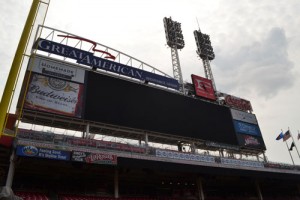Managing turf for the Midsummer Classic

 Imagine the brightest lights in your profession on the best athletes in the sport and millions of eyes watching TV all on the turf you maintain.
Imagine the brightest lights in your profession on the best athletes in the sport and millions of eyes watching TV all on the turf you maintain.
That is what Steve Lord, head groundskeeper at Great American Ball Park, is facing when MLB’s annual All-Star Game will be played on his field July 14.
“This is a once in a career type of event to host,” Lord says. “It’s exciting to have this opportunity when I am so early into my career.”
When Lord says early, he means early. He has spent the last eight seasons under Dennis Klein as the assistant groundskeeper with the Texas Rangers. With that experience under his belt, Lord moved to Cincinnati and into his current position with the Cincinnati Reds in March.
For the Michigan State turf school alumnus and Michigan native it was an easy job to accept. “It was a chance to get back closer to home and head groundskeeper jobs in the MLB don’t come around often,” Lord says.
Despite being new in town and in his first head groundskeeper job, Lord isn’t too concerned about the preparations because of the two assistants he inherited, Derrick Grubbs, assistant head groundskeeper, and Robbie Dworkin, grounds supervisor.
“I have the most talented crew,” Lord says. Grubbs also is a talented artist and has free-hand painted Reds logos all over. (Check out the slideshow below for some examples of Grubbs’ artwork.)
Lord also has three more seasonal crewmembers that work from April to October and will have another ten on the field for Reds’ home games. During the All-Star festivities he has another 15 workers coming in to lend a hand from different MLB and Minor League teams.
Lord’s biggest worry? Stress on the turf, especially the extra traffic that the public never sees.
“Beyond the major events like the All-Star Game, the Home Run Derby and the Futures Game there are corporate events and a lot of rehearsals,” Lord says. “Every musical performance needs to be practiced with stages and equipment being moved on and off the field.”
To prepare the 100 percent perennial ryegrass field for the upcoming stress Lord has a specific program in place. They overseed throughout the year, but Lord will usually only aerate with solid tine as needed and two weeks ago he had the crew go out with 3/8-inch pencil tines at a depth of 4.5 inches.
The turf on infield and outfield will have a unique design mowed into it for the All-Star Game. Leading up to the game Lord’s crew is using a walk-behind mower on the infield, and the outfield will be mowed with a different design each day to prevent any other lines or designs from showing up during the All-Star festivities.
When it comes to spraying, they are on an aggressive 10-day program. That has worked for them because Lord says there has not been any disease issues on the field in his first four months, but it’s the infield dirt he deals with more.
“The hardest part of maintenance is on the dirt,” Lord says. “There has to be a consistent moisture and you can only work with what Mother Nature gives you.”
The Reds get their infield and warning track mixes from the Natural Sands Company. The warning track mix really stands out to Lord.
“It is softer when it is dry but the dirt sets firm when it rains and doesn’t get mucky like clay,” Lord says.
That ability to stay firm is important for the Reds’ grounds crew because Cincinnati has had more annual total rain accumulation than Seattle.
- Media: Athletic Turf
- Media: Athletic Turf
- Media: Athletic Turf
- Media: Athletic Turf
- Media: Athletic Turf
- Media: Athletic Turf
- Media: Athletic Turf
- Media: Athletic Turf
- Media: Athletic Turf
- Media: Athletic Turf
- Media: Athletic Turf
- Media: Athletic Turf
- Media: Athletic Turf
- Media: Athletic Turf
- Media: Athletic Turf
- Media: Athletic Turf
Media: Athletic Turf


























